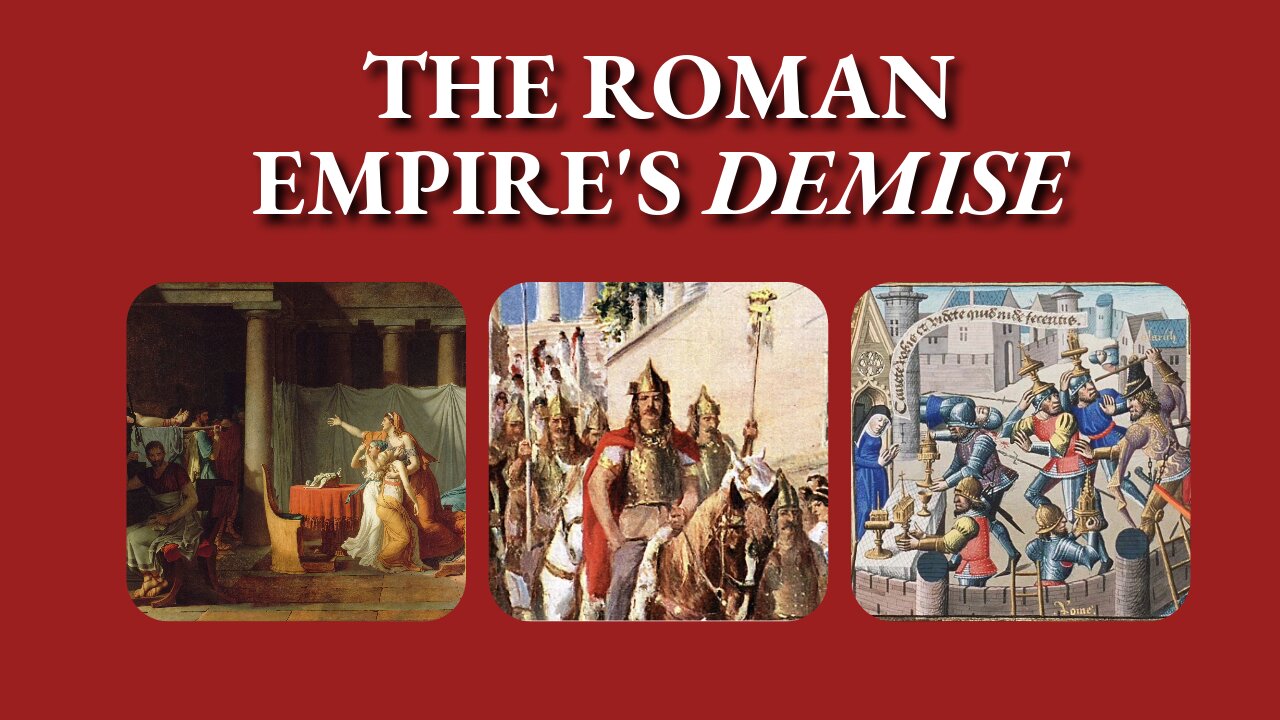Premium Only Content

Decay and Demise: Unveiling the Chronicles of the Roman Empire's Fall
The Roman Empire holds immense historical importance as a foundational civilization whose contributions span politics, law, governance, architecture, engineering, art, literature, and culture.
At its zenith in 117 AD, it stretched across 2.3 million square miles, encompassing Africa, Asia, and Europe, with an estimated 60 million inhabitants. It stood as one of history's grandest and mightiest empires. However, its sprawling size became unsustainable.
The decline began shortly after Emperor Trajan's death in 117 when Mesopotamia was lost to the Parthians. Rome never regained this territory. In Europe, defending the vast Germania border strained resources.
In 212, Caracalla's Antonine Constitution granted citizenship to free men across the empire, promoting Roman identity. The Romans, however, viewed non-Romans, especially Germanic tribes, as barbarians.
The decline began in earnest during the 3rd century, a period often referred to as the "Crisis of the Third Century." This tumultuous era was characterized by frequent changes in leadership, military crises, economic instability, and a breakdown of central authority. Starting in 235, a succession of short-lived emperors ruled the empire, often coming to power through military coups or assassinations. The assassination of Emperor Alexander Severus marked the beginning of this chaotic period.
Rome faced constant pressure at it's borders. In the east, the Sassanid Empire (Persia) became a formidable adversary and engaged in a series of wars with Rome. In the west, Germanic tribes, particularly the Goths, began to pose a significant threat. In 251, the Roman Empire suffered a humiliating defeat at the hands of the Goths at the Battle of Abritus, during which Emperor Decius was killed.
The Roman economy also faced severe challenges during this period. Heavy taxation, rampant inflation, and a debased currency (the denarius) eroded the wealth of the empire. The government's efforts to address these economic issues often fell short, leading to further instability.
Emperor Diocletian came to power in 284 and initiated a series of reforms known as the "Tetrarchy." He divided the empire into eastern and western halves, each with its own emperor and subordinate "Caesars." He implemented price controls and strengthened the imperial bureaucracy. While these reforms brought temporary stability, they were not enough to halt the empire's long-term decline.
Constantine the Great, who ruled from 306 to 337, is known for his conversion to Christianity and his establishment of Constantinople (modern-day Istanbul) as the new eastern capital of the Roman Empire in 330. This move signaled a significant shift in the center of power from Rome to the eastern provinces. While it brought administrative efficiency and security to the east, it also contributed to the gradual decline of the western half of the empire.
The Visigoths famously sacked Rome in 410, marking the first time the city had been captured in over 800 years. In 451, the Huns, led by Attila, invaded the western provinces, causing widespread devastation. While these attacks were repelled, they weakened the Roman Empire's ability to defend its borders.
The internal division and power struggles among Roman leaders further contributed to the empire's decline. Civil wars became increasingly common, as different generals and provincial leaders vied for control. The divide between the eastern and western halves of the empire also deepened.
In 476, the Roman Empire suffered a devastating blow when the Germanic chieftain Odoacer deposed the last Roman emperor, Romulus Augustulus. This event is traditionally regarded as the fall of the Western Roman Empire.
While the western half of the Roman Empire crumbled, the eastern half, known as the Byzantine Empire, continued to thrive for several centuries. They preserved Roman traditions, culture, and governance. The Byzantine Empire would endure until the fall of Constantinople in 1453, marking the end of the Roman legacy in the east.
Historians cite myriad reasons for Rome's fall, from economic decline to external pressures. Internally, economic instability eroded Rome's tax base and disrupted long-distance trade, fracturing the empire's unity. Externally, increasing numbers of outsiders, including Germanic tribes, sought to join Rome, not conquer it. However, Rome's lingering disdain for these newcomers hindered integration.
The Roman Empire's legacy endures. It left an indelible mark on Western civilization, influencing art, architecture, law, language, and governance.
Photo credits - Jean-Pol GRANDMONT, David Corral Gadea, José Luiz Bernardes Ribeiro, Marie-Lan Nguyen, British Museum, DAVID ILIFF, Hartmann Linge, Cjcaesar, Ninara, Classical Numismatic Group, Inc, Rabax63, Bigdaddy1204 @ wiki commons
Music - Trumpets in Your Ears by Wowa & Chris Rede, Piratos by Wowa @unminus.com
-
 2:00:10
2:00:10
Bare Knuckle Fighting Championship
3 days agoCountdown to BKFC on DAZN HOLLYWOOD & FREE LIVE FIGHTS!
36K3 -
 2:53:01
2:53:01
Jewels Jones Live ®
1 day agoA MAGA-NIFICENT YEAR | A Political Rendezvous - Ep. 103
71.4K22 -
 29:54
29:54
Michael Franzese
10 hours agoCan Trump accomplish everything he promised? Piers Morgan Article Breakdown
87.6K47 -
 2:08:19
2:08:19
Tactical Advisor
14 hours agoThe Vault Room Podcast 006 | Farwell 2024 New Plans for 2025
166K11 -
 34:12
34:12
inspirePlay
1 day ago $4.94 earned🏆 The Grid Championship 2024 – Cass Meyer vs. Kelly Rudney | Epic Battle for Long Drive Glory!
71K8 -
 17:50
17:50
BlackDiamondGunsandGear
11 hours ago $1.70 earnedTeach Me How to Build an AR-15
46.1K6 -
 9:11
9:11
Space Ice
1 day agoFatman - Greatest Santa Claus Fighting Hitmen Movie Of Mel Gibson's Career - Best Movie Ever
107K45 -
 42:38
42:38
Brewzle
1 day agoI Spent Too Much Money Bourbon Hunting In Kentucky
71.3K12 -
 1:15:30
1:15:30
World Nomac
20 hours agoMY FIRST DAY BACK in Manila Philippines 🇵🇭
54.6K9 -
 13:19
13:19
Dr David Jockers
1 day ago $10.68 earned5 Dangerous Food Ingredients That Drive Inflammation
74.4K17